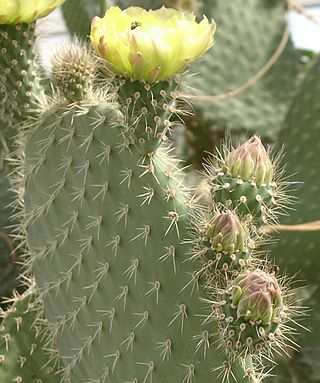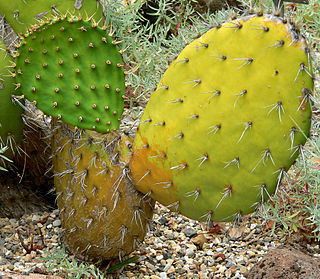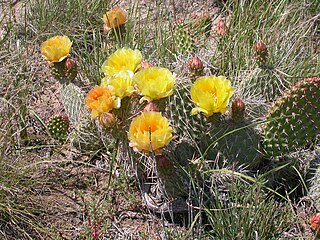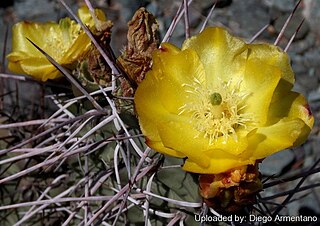
Opuntia ficus-indica, the Indian fig opuntia, fig opuntia, or prickly pear, is a species of cactus that has long been a domesticated crop plant grown in agricultural economies throughout arid and semiarid parts of the world. O. ficus-indica is the most widespread and most commercially important cactus. It is grown primarily as a fruit crop, and also for the vegetable nopales and other uses. Cacti are good crops for dry areas because they efficiently convert water into biomass. O. ficus-indica, as the most widespread of the long-domesticated cactuses, is as economically important as maize and blue agave in Mexico. Opuntia species hybridize easily, but the wild origin of O. ficus-indica is likely to have been in central Mexico, where its closest genetic relatives are found.

Opuntia engelmannii is a prickly pear common across the south-central and Southwestern United States and northern Mexico. It goes by a variety of common names, including desert prickly pear, discus prickly pear, Engelmann's prickly pear in the US, and nopal, abrojo, joconostle, and vela de coyote in Mexico.

Opuntia stricta is a species of large cactus that is endemic to the subtropical and tropical coastal areas of the Americas, especially around the Caribbean. Common names include erect prickly pear and nopal estricto (Spanish). The first description as Cactus strictus was published in 1803 by Adrian Hardy Haworth. In 1812 he moved the species to the genus Opuntia.

Opuntia phaeacantha is a species of prickly pear cactus known by the common names brown-spine prickly pear, tulip prickly pear, and desert prickly pear found across the southwestern United States, lower Great Plains, and northern Mexico. The plant forms dense but localized thickets. Several varieties of this particular species occur, and it may hybridize with other prickly pears, making identification sometimes tricky.

Opuntia monacantha, commonly known as drooping prickly pear, cochineal prickly pear, or Barbary fig, is a species of plant in the family Cactaceae native to South America.

Opuntia leucotricha is a species of cactus with the common names: arborescent pricklypear, Aaron's beard cactus, and semaphore cactus; and duraznillo blanco and nopal blanco.

Opuntia basilaris, the beavertail cactus or beavertail pricklypear, is a cactus species found in the southwest United States. It occurs mostly in the Mojave, Anza-Borrego, and Colorado Deserts, as well as in the Colorado Plateau and northwest Mexico. It is also found throughout the Grand Canyon and Colorado River region as well as into southern Utah and Nevada, and in the western Arizona regions along the Lower Colorado River Valley.

Opuntia humifusa, commonly known as the devil's-tongue, eastern prickly pear or Indian fig, is a cactus of the genus Opuntia present in parts of the eastern United States and northeastern Mexico.

Opuntia littoralis is a species of prickly pear cactus known by the common name coastal pricklypear. It is sometimes called the sprawling prickly pear due to its short stems and habit of growing close to the ground. "Littoral" means "pertaining to the seashore".

Opuntia oricola is a species of prickly pear cactus known by the common name chaparral prickly pear. It is native to southern California and Baja California, where it grows in coastal sage scrub and chaparral habitats.

Pediocactus bradyi is a very rare species of cactus known by the common names Brady's pincushion cactus, Brady's hedgehog cactus, and Marble Canyon cactus. It is endemic to Arizona in the US, where it is restricted to Marble Canyon in Coconino County, though its exact distribution is not generally advertised due to poaching concerns. It is limited to a specific type of soil, it has a small distribution, and the species is threatened by a number of human activities. This has been a federally listed endangered species of the United States since 1979.

Opuntia polyacantha is a common species of cactus known by the common names plains pricklypear, starvation pricklypear, hairspine cactus, and panhandle pricklypear. It is native to North America, where it is widespread in Western Canada, the Great Plains, the central and Western United States, and Chihuahua in northern Mexico. In 2018, a disjunct population was discovered in the Thousand Islands region of Ontario, Canada.

Opuntia macrocentra, the long-spined purplish prickly pear or purple pricklypear, is a cactus found in the lower Southwestern United States and Northwestern Mexico. A member of the prickly pear genus, this species of Opuntia is most notable as one of a few cacti that produce a purple pigmentation in the stem. Other common names for this plant include black-spined pricklypear, long-spine prickly pear, purple pricklypear, and redeye prickly pear.

Opuntia pinkavae, common names Bulrush Canyon prickly-pear or Pinkava's pricklypear, is a species of cactus known only from northern Arizona and southern Utah. It grows in sunny locations in grasslands, on the edges of pinyon-juniper woodlands, on sandy or limestone soils.

Opuntia rufida is a species of prickly pear cactus native to southwestern Texas and northern Mexico, where it grows on rocky slopes. The species makes up for its total lack of spines with a profusion of red-brown glochids. The common name blind prickly pear or cow blinder comes from the fact that the glochids may be carried away by the wind and blind animals.
Opuntia abjecta is a short cactus, perhaps to 15(25) cm tall. It occurs in the Florida Keys and has been conflated with O. triacantha. Recent work shows that the two taxa are distinct. In addition to morphological and phylogenetic (DNA) differences, O. triacantha occurs in Cuba, whereas O. abjecta occurs in Florida. Currently It is Listed as critically endangered by the IUCN Red List.

Opuntia sulpurea falls under the Opuntia, or prickly pear, genus within the family Cactaceae named such because of their round shape, green color, and long thick spines. Opuntia sulphurea is the widest spread of the Opuntia that can be found in and around Argentina, occupying mostly arid areas of the region from the plains in the Western portion of Argentina up to much higher altitudes on the Eastern side of the Andes mountain range. As a result of its ability to survive in such a diverse array of environments there are several subspecies of O. sulphurea that are identifiable based on the number of spine per areole, for example. A commonality across the three is a bright yellow flower, often considered to be the color of sulfur, from which the species name is derived. As with several other species of Opuntia, these prickly pears tend to grow in groups, forming clumps that can reach one to two meters in diameter, but while other species within the genus grow upwards as well O. sulphurea tend to stay low to the ground. As a result of its tendency to grow in dry, arid, and rocky areas this cactus has evolved to be very resilient, not even suffering from the effects of agriculture, i.e. cattle grazing, on lower altitude subpopulations.

Opuntia huajuapensis, commonly known as the Huajuapan prickly pear or the Chumbera, is a species of prickly pear cactus in the family Cactaceae. It was described by Helia Bravo Hollis in 1953, and named for the town of Heroica Ciudad Huajuapan de León, Oaxaca, from which the first specimens were described.
Opuntia lagunae, commonly known as the Laguna prickly pear or the shrubby prickly pear, is a species of prickly pear cactus in the family Cactaceae. It was described by Edgar Martin Baxter.

Opuntia austrina, also known as the Florida prickly pear, is a prickly pear cactus species that is endemic to Florida in the United States.



















